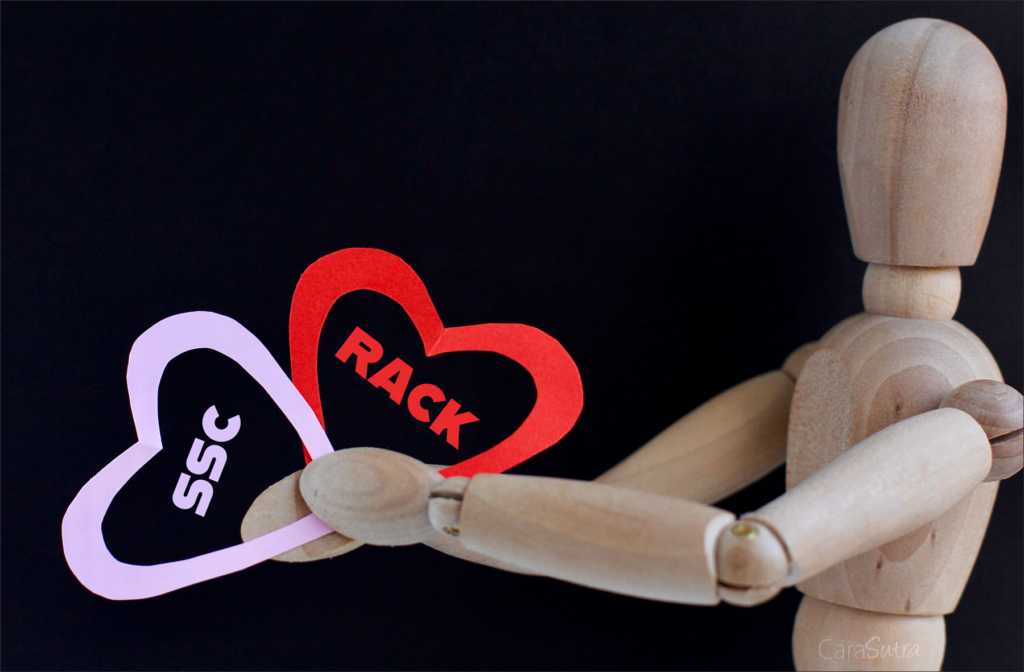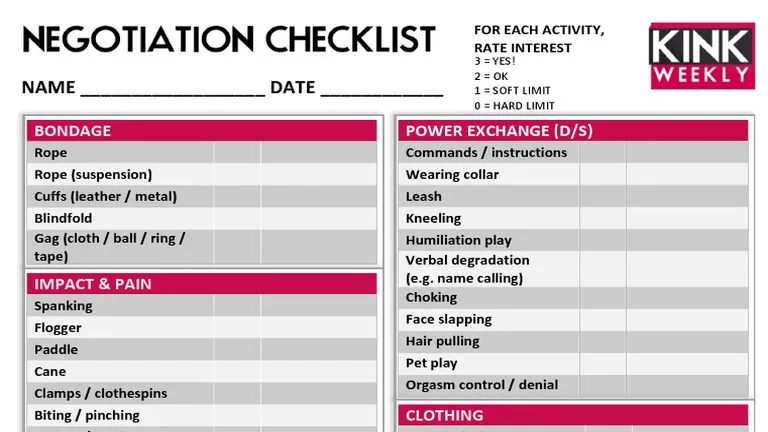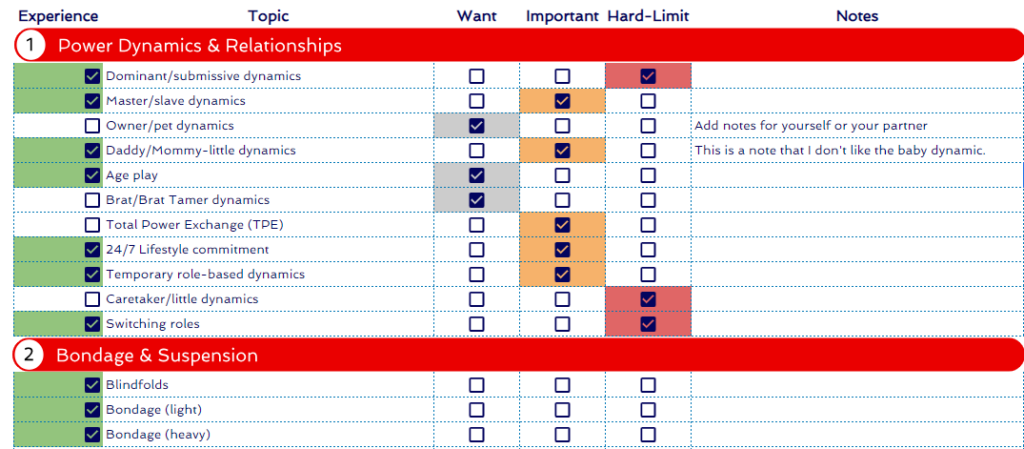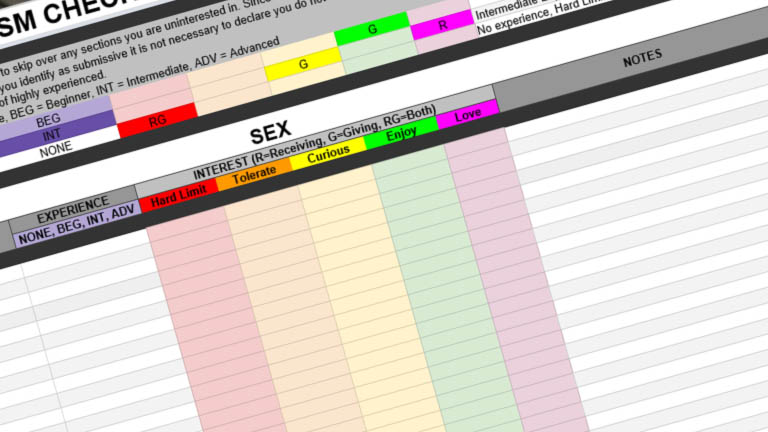What’s a bdsm checklist? At its core, it’s a simple way to map out your yes/no/maybe list, set hard and soft limits, and make sure safety and consent are clear before you dive into anything. Think of it as a tool for negotiation, aftercare planning, and keeping the fun parts fun while avoiding awkward surprises.
Here’s what you’ll find in this guide:
- How to use a bdsm limits list to set boundaries you’re comfortable with
- Ways to turn a kink checklist into an easy negotiation guide
- Why yes/no/maybe lists are so helpful for beginners and pros alike
- Tips for weaving in aftercare, safety, and ongoing consent
The checklist itself is only half the story. To get the most out of it, you need to understand the foundations that make it work—things like consent frameworks, safewords, and how to talk about limits without killing the mood. That’s where we’ll start.
Table of Contents
- Understanding the Foundations Before You Check Boxes
- Core Domains of a BDSM Checklist
- A Fillable BDSM Checklist with Explanations
- How to Use the Checklist in Practice
- Edgeplay, Advanced Risks & When to Consult Experts
- Additional Resources & Tools for BDSM Checklists
- BDSM Checklist Final Thoughts
- Want More BDSM Reads?
Understanding the Foundations Before You Check Boxes

Before you even glance at a bdsm checklist, it helps to ground yourself in the basics: what consent really means, how negotiation works, and which safety frameworks experienced kink communities rely on. This foundation makes the checklist more than a piece of paper — it turns it into a living agreement that protects everyone involved.
Consent, Negotiation & Power Exchange
Consent in BDSM is not a one-time “yes.” It’s ongoing, specific, and must be freely given without pressure. When people talk about a bdsm negotiation guide, what they usually mean is a structured conversation before play where each person says what they want, what they don’t, and how they prefer to be checked in with.
A practical way to start is to break things into three parts:
- Pre-scene negotiation — Talk through interests, limits, and emotional state. Clarify what’s absolutely off the table (hard limits) versus what might be okay in the right mood (soft limits).
- Active consent during play — Agree on a quick way to pause, slow down, or stop if something doesn’t feel right. This can be verbal (like safewords) or non-verbal (a gesture if someone is gagged).
- Post-scene check-in — After play, talk about what worked, what didn’t, and how you both felt. This is where aftercare starts, and it keeps your dynamic healthy over time.
The power exchange in BDSM — whether you lean dominant, submissive, or switch roles — only works because the negotiation is explicit. Without that, it isn’t power exchange, it’s just taking risks in the dark.
Safety Philosophies: SSC, RACK & Risk Awareness
In the kink community, two big frameworks often come up: Safe, Sane, and Consensual (SSC) and Risk-Aware Consensual Kink (RACK). They’re not competing rules, but different philosophies you can lean on depending on your style.
- SSC (Safe, Sane, Consensual): This mindset says activities should be reasonably safe, grounded in sound judgment, and fully consensual. It’s a good starting point for beginners because it sets clear guardrails. For example, you wouldn’t attempt fire play if you’ve never practiced basic rope safety.
- RACK (Risk-Aware Consensual Kink): This framework acknowledges that no activity is 100% safe. Even impact play or bondage carries risks. Instead of pretending risks don’t exist, RACK emphasizes learning what the risks are, talking about them openly, and consenting to them knowingly.
Both approaches underline the same point: your bdsm checklist isn’t a free pass to do anything you want. It’s a roadmap for shared responsibility. Whether you write “yes” next to spanking or “maybe” next to breath play, the decision should be made with a real understanding of the risks involved.
Safewords, Stoplight Systems & Communication Signals
Even with negotiation and philosophy, you need a live “safety net” during play. This is where safewords and stoplight systems come in.
- Single safeword: The classic model. Pick a word that you’d never normally say in play — like “pineapple” — and agree it means “stop now.”
- Traffic-light system: Widely used because it allows nuance. “Green” means everything’s good, “yellow” means slow down or check in, and “red” means stop immediately.
- Non-verbal signals: Essential if someone might be gagged or too overwhelmed to speak. This could be dropping a held object, tapping out, or using a pre-agreed hand gesture.
The real key is practicing them. Try saying or signaling your safeword outside of play so it feels natural. Reassure your partner that using it doesn’t “ruin” the moment — it proves trust is working. When you integrate safewords into your dynamic, your bdsm checklist stops being just a written document and becomes part of an active system of safety.
👉 This section lays the groundwork: negotiation, consent, SSC vs RACK, and safewords are what make a checklist meaningful. Once you’re clear on these, the next step is understanding the different domains a checklist can cover — physical play, emotional limits, triggers, and aftercare.
Core Domains of a BDSM Checklist

A bdsm checklist works best when it goes beyond a list of toys or positions. Real negotiation has layers: what you do with your body, how you use your headspace, what lines you never want crossed, and how you’ll care for each other before and after. By thinking across these domains, your bdsm limits list becomes a full picture of what makes play safe, hot, and sustainable.
Physical / Sensation Activities
This is the part most people expect — spanking, bondage, sensation play, impact toys, and all the tactile things you might try. A checklist helps you sort these into categories: hard yes, maybe, or absolutely not.
For example:
- Impact play: spanking, flogging, caning, paddling.
- Bondage: rope, cuffs, spreader bars.
- Sensation play: wax, feathers, ice, vibration, electrostimulation.
Instead of lumping them together, a detailed checklist lets you mark what excites you, what you’re curious about, and what you never want attempted. Breaking things down this way avoids vague answers like “I’m into bondage” — which can mean very different things depending on the person.
Psychological & Emotional Play
A bdsm checklist isn’t only about physical activities. Psychological play — things like roleplay, humiliation, degradation, or praise — can have even stronger effects than pain or restraint. This is where a role play boundaries checklist becomes crucial.
Examples to cover here include:
- Power-based roleplay (teacher/student, boss/employee, owner/pet).
- Verbal play (name-calling, praise, degradation).
- Mind games (tease and denial, psychological control).
These elements can feel thrilling for one person and cutting for another. Writing them down before you experiment keeps the fun from crossing into hurtful.
Triggers, Trauma & Mental Safety
This is where a trauma informed bdsm checklist adds depth. Everyone carries life experiences that shape how they respond to play. Something harmless to one person might be triggering to another.
Your checklist should give space to:
- Note words, actions, or scenarios that are triggering.
- Highlight physical spots that shouldn’t be touched.
- Record emotional boundaries (e.g. “no medical roleplay,” “don’t use religious language,” “avoid parental roles”).
By adding triggers to a bdsm checklist, you’re not being “too sensitive” — you’re protecting yourself and your partner from accidents that could cause real harm.
Aftercare, Check-ins & Emotional Support
A bdsm checklist that ignores aftercare is incomplete. “Aftercare” refers to the steps you and your partner take once the scene ends: cooling down, cuddling, talking, or giving space, depending on needs.
Common aftercare items to consider:
- Physical: water, snacks, warm blankets, ointments or ice packs.
- Emotional: reassurance, cuddles, talking through feelings, or quiet time.
- Practical: scheduling a check-in the next day if the scene was intense.
Including aftercare in your checklist ensures both partners feel supported. It’s just as important to mark “I need alone time after play” as it is to say “I like to be held.”
Health, Hygiene & Medical Considerations
Chronic Conditions and Physical Limits
- If you have asthma, note how it could interact with breath play or positions that compress your chest. Keep an inhaler nearby.
- For diabetes, mark whether you need snacks or breaks, since low blood sugar can mimic sub drop. Partners should know the signs.
- Old injuries matter. A bad shoulder makes suspension rope dangerous. Bad knees limit kneeling positions. Write down what positions cause strain so they can be avoided or modified.
Allergies and Skin Sensitivities
- Latex allergies are common — gloves, condoms, and even certain lingerie can trigger reactions. If that’s you, specify “no latex” in your checklist.
- Lube matters too. Water-based, silicone, and oil-based all interact differently with toys and condoms. Someone with sensitive skin may break out after oil-based lube.
- Cleaning products are another hidden risk. If your partner uses bleach on toys, that could cause burns or rashes. Document it.
STI/STD Status and Safer Sex Expectations
- Your checklist should say whether condoms, dental dams, or gloves are a must.
- Include agreements about testing frequency (every 3 months, twice a year, etc.) and whether results are shared.
- If blood play or cutting is on the table, write down expectations clearly — from sterile tools to post-scene wound care.
Hygiene Prep and Scene Practicalities
- Some types of play need advance prep. Anal play? Decide if enemas, showering, or no prep at all is your norm.
- Toys should be listed with care instructions: what material they’re made of, how to clean them, and what lube is safe to use.
- Bondage gear that touches skin (rope, leather cuffs) should be washed or disinfected. Your checklist can include a reminder for “gear cleaned before scene.”
Emergency and Medical Readiness
- Note if you’re on meds that could interact with physical stress (blood thinners, antidepressants, pain meds).
- If someone faints, do you know how to recover them safely? Write whether you’re trained in CPR or first aid.
- Keep a small first-aid kit in your play space: bandages, antiseptic wipes, gloves, scissors (to cut rope in emergencies).
This is the unsexy backbone of kink. Adding these medical considerations into your bdsm limits list makes sure that when things get intense, you’re not improvising in a crisis. It tells your partner exactly how to keep you safe — and that makes the scene stronger, not weaker.
A Fillable BDSM Checklist with Explanations

A checklist only works if it’s easy to use. Most people rely on the yes/no/maybe list bdsm format because it gives three simple choices: yes (interested), no (not interested), and maybe (curious but needs discussion). From there, you can expand into weighted intensity scales or even a printable bdsm checklist you can keep on hand. Below is a small sample grid to show how it works.
Yes / No / Maybe Grid (Master List)
| Activity | Yes | No | Maybe | Notes / Boundaries |
|---|---|---|---|---|
| Spanking (hand) | ✅ | Okay over clothes, no marks | ||
| Bondage (rope) | ✅ | Must have safety shears nearby | ||
| Blindfolds | ✅ | Fine anytime | ||
| Roleplay (teacher/student) | ✅ | Off-limits – not comfortable | ||
| Temperature play (ice) | ✅ | Okay, avoid genitals |
This kind of table makes it clear where each person stands without needing to read between the lines. It’s the difference between saying “I like bondage” and explaining what kind of bondage, under what limits, with what safety backup.
Weighted Preference & Intensity Scale
Sometimes “yes” isn’t enough. A fillable PDF bdsm limits checklist often uses a rating scale (0–5) to show how strongly you feel about something. That way your partner knows the difference between “sure, I’ll try it” and “please, I crave this.”
Example using a 0–5 scale (0 = never, 5 = love it every time):
| Activity | Rating (0–5) | Notes |
|---|---|---|
| Spanking (hand) | 5 | Love harder impacts, okay with marks |
| Bondage (rope) | 2 | Curious, but only short sessions |
| Roleplay (praise) | 4 | Works well when combined with aftercare |
| Wax play | 1 | Nervous – need practice first |
This scale turns vague “maybes” into something you can plan with. It also helps avoid overdoing a “yes” activity when one person meant “lightly” and the other thought “go all out.”
Conditional Logic & Customization Tips
The most powerful part of a digital bdsm checklist is customization. Tools and apps let you set conditions — for example, if you mark “bondage = yes,” it can automatically ask: “Rope, cuffs, chains, or tape?” If you say “impact play,” it may follow up with “Are marks okay?” or “What body areas are off-limits?”
This dynamic checklist bdsm style prevents gaps in communication. A static sheet can miss nuances, while a digital version can expand with follow-up questions. That’s why many couples start with a printable bdsm checklist and then move toward an evolving digital one.
Over time, revisiting your answers turns this into an evolving bdsm checklist. Maybe something that was a “no” shifts into a “maybe” after you learn more. Or maybe something that was a “yes” turns into a hard limit because it didn’t feel right. That’s normal. The point of keeping it in a living document — whether a paper sheet or a bdsm consent form template online — is that it grows with you.
When used this way, a checklist stops being a static worksheet and becomes an ongoing dialogue. It’s not about filling boxes once — it’s about giving yourself a flexible tool you can actually rely on.
How to Use the Checklist in Practice

A bdsm checklist isn’t magic just because it’s filled out. Its real value comes from how you put it into practice — first by reflecting on your own, then comparing with a partner, and finally using it to shape actual scenes. Whether you’re brand new or you’ve been around for years, the process is the same: treat it like a conversation tool that changes as you do.
Solo Reflection Phase
Before you ever share a sheet, take time to fill it out on your own. This isn’t about what you think your partner wants — it’s about being honest with yourself. Sit down with the checklist, go line by line, and notice your gut reactions. If you hesitate, mark it as a “maybe” and add notes.
This step is especially helpful if you’re nervous about how to negotiate a bdsm checklist for beginners. Reflection gives you the language to explain your feelings later, instead of freezing up or defaulting to whatever your partner suggests. Think of it as building your vocabulary of limits, curiosities, and desires.
Partner Discussion & Negotiation
Once you’ve done your solo work, swap checklists with your partner. Compare similarities, highlight differences, and ask questions. If one of you says “yes” to rope and the other marks “maybe,” that’s not a dead end — it’s a starting point for dialogue.
A simple way to structure the talk:
- Start with the easy “yes” items to build excitement.
- Then move to the “maybe” column, asking what conditions would turn it into a “yes.”
- Leave the “no” column untouched. Respecting those is non-negotiable.
This phase is also where you can talk about switching roles. A checklist for role exchange helps partners who want to try both dominance and submission. Marking separate answers for “giving” versus “receiving” keeps things clear.
First-Time Scene Planning Based on the Checklist
The first scene you plan using a checklist should be simple. Pick a handful of clear “yes” items that both of you marked strongly. Keep the session short and set aside time for aftercare.
If you’re new, don’t feel pressured to cram in every curiosity at once. Even a seasoned kinkster checklist vs beginner version shows that veterans pace themselves. They know it’s better to go deep on one or two activities than to rush through ten and burn out. Beginners can learn from that: slow is sustainable.
Revisiting, Reevaluating & Evolving the Checklist
Your answers today aren’t permanent. Tastes change, limits shift, and comfort zones expand or contract. That’s why it’s smart to reevaluate bdsm preferences regularly. Some couples review after every major scene, others do it every few months.
Signs it’s time for a revisit:
- You find yourself curious about something you once marked “no.”
- A “yes” activity suddenly feels uncomfortable.
- You’re adding new partners or changing roles.
- Emotional or life changes shift your headspace.
An evolving checklist isn’t about chasing novelty — it’s about keeping your agreements current. Treat it like a living document. The more often you update it, the more reliable it becomes as a guide for safe, satisfying play.
Edgeplay, Advanced Risks & When to Consult Experts
Not everything belongs on a beginner’s bdsm checklist. Some activities are considered edgeplay — things like breath control, knife play, fire, or blood play. These carry higher risk and demand specialized knowledge. If you’re new, mark them as “no” or “maybe” until you’ve learned what’s involved.
What “Edgeplay” Means & Common Forms
Edgeplay refers to scenes where the chance of injury or emotional harm is significantly higher. Examples include choking, cutting, fire, and mock non-consent. Each requires extreme caution, risk discussion, and backup plans.
Decision Tree for Assessing Risk
A quick edgeplay risk assessment could look like this:
- Do I know the safety protocols?
- Do I have the right gear and emergency supplies?
- Do I fully trust my partner?
- Have we practiced safer, lower-intensity versions first?
If any answer is “no,” pause. That’s a sign you need more prep.
When to Train, Learn, or Hire a Mentor / Pro
For anything beyond light impact or restraint, consider formal learning. Workshops, vetted community classes, or mentoring are the safest paths. Advanced kink safety often comes down to hands-on practice under guidance — not YouTube clips or trial and error.
Additional Resources & Tools for BDSM Checklists
- Sadomasochism Checklist (SMCL) – Academic 24-item tool for assessing BDSM practices (ResearchGate)
- Jester Presents Resources – Curated guides on negotiation, safety, and kink education (Jester Presents)
- Green Center Therapy Kink Safety Guide – Intro to SSC, RACK, and consent basics (Green Center Therapy)
- Society of Janus – Longstanding BDSM education and community org (Wikipedia)
- FetLife – Global BDSM/kink social network and community hub (Wikipedia)
BDSM Checklist Final Thoughts
A bdsm checklist is more than a form — it’s a tool for trust, safety, and better play. By mapping out limits, maybes, and aftercare needs, you create space for deeper connection and more freedom to explore.
If you want to bring that exploration into real play, app-controlled toys like those from Lovense add another layer — perfect for edging, power exchange, or even discreet fun in public. Combined with a checklist, they turn negotiation into something you can feel in the moment.
Want More BDSM Reads?
- Ultimate BDSM Aftercare Kit: 50+ Ideas and Tips to Recover & Reconnect
- What is a BDSM Slave? Learn the Difference from Submissive
- Top Vs a Dominant? Learn the Big Difference
- BDSM vs Abuse – Learn the Differences and Stay Safe


